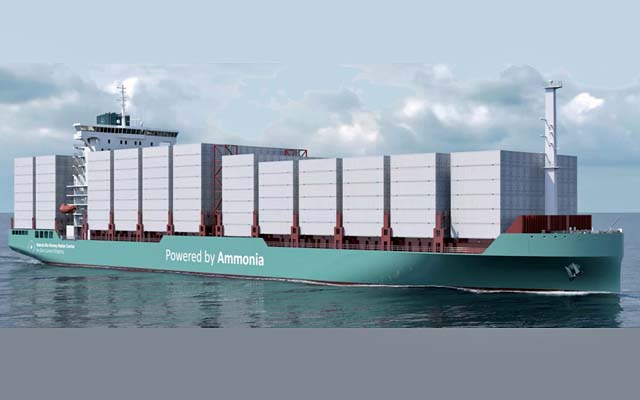Two classification societies, American Bureau of Shipping (ABS) and Lloyd’s Register (LR), have awarded a new ship design of an ammonia-fueled 3,500 TEU container vessel Approval in Principle (AiP).
A cross-industry taskforce including A. P. Møller-Mærsk, MAN Energy Solutions, Deltamarin, Eltronic FuelTech, ABS, and LR, and led by the Mærsk Mc-Kinney Møller Center for Zero Carbon Shipping (MMMCZCS), is behind the new design. The result of this collaborative approach is considered a milestone in enabling ammonia as an alternative marine fuel.
Claus W. Graugaard, CTO Onboard Vessel Solutions MMMCZCS said: “To unlock the potential of sustainable ammonia as an alternative, low-emissions marine fuel, we must carefully address the safety issues on board and ensure a safe and healthy working environment for our seafarers and people in ports. The AiP of the new ship design is a major milestone on this journey, as it demonstrates that safety criteria for the application of ammonia as the main fuel is within tolerable levels of industry safety management practices. The fact that we have both ABS and LR granting this AiP in parallel is a testimony to the robustness of the design and to the iterative risk assessment and systematic risk management intelligence that have gone into it. This development work has only been possible because all project partners have contributed with innovative thinking and willingness to share knowledge. Collaboration is the fastest way to co-creating the prescriptive rules and innovative solutions we need.”
When awarding an AiP, the classification societies perform a novel technology evaluation to examine all fundamental aspects of the ship design and general compliance with the associated rules/regulations. An AiP is not a regulatory approval, as these are issued by flag state administrations. Next, the remarks raised on the design will be addressed and MMMCZCS will continue to lead this work looking into extending the project to a second phase with partners including a charterer and ship owner.
John McDonald, ABS President and COO said: “This project is an important step on the road to the wider adoption of ammonia as a marine fuel by the industry. ABS is committed to utilizing our highly specialized technical knowledge and research capabilities to explore viable, safe solutions for our clients’ decarbonization challenges. ABS is proud to contribute to this project team and to the work of the Mærsk Mc-Kinney Møller Center for Zero Carbon Shipping.”
LR CCO Andy McKeran said: “Safety remains a critical aspect for the widespread adoption of ammonia as a marine fuel. This AiP demonstrates a clear cross-sector intention to ensure that ambition becomes reality. Through our previous collaborations, including the joint study with the Mærsk Mc-Kinney Møller Center for Zero Carbon Shipping and the LR Maritime Decarbonisation Hub into Quantitative Risk Assessment for ammonia ship design, LR has continued to build on its expertise as a trusted adviser to the maritime value chain, enabling us to put the mitigation of risks for ammonia vessels at the heart of our AiP process.”
The design outlines a commercially viable and safe ammonia-fueled 3,500 TEU container feeder. The focus has been on achieving an adequate level of safety for crew, and at the same time minimizing loss of cargo capacity. The ammonia tank capacity (4,000 m3) was selected for a full roundtrip of relevant trades for this vessel. A. P. Møller-Mærsk has contributed with vast experience on the ship design part; MAN Energy Solutions with engine manufacturer/supplier expertise, as the vessel features the first commercially available ammonia engine; and ABS and LR with safety and statutory standard expertise throughout the design and risk assessment process. The detailed concept design was created by the ship design house Deltamarin, and the detailed fuel system supply by Eltronic FuelTech. Two flag states, DMA and MPA, participated in the project’s risk assessments.
Image: 3500 TEU ammonia-fuelled container ship (source: Mærsk Mc-Kinney Møller Center for Zero Carbon Shipping)



